seats FORD GT 2020 Owners Manual
[x] Cancel search | Manufacturer: FORD, Model Year: 2020, Model line: GT, Model: FORD GT 2020Pages: 316, PDF Size: 6.25 MB
Page 4 of 316

Introduction
About This Manual
..........................................5
Symbols Glossary ............................................
5
Data Recording ..................................................
7
Perchlorate .......................................................
10
Replacement Parts Recommendation ........................................................................\
.....
11
Special Notices ................................................
11
Mobile Communications Equipment ........................................................................\
....
12
Ford Performance ..........................................
13
Environment
Protecting the Environment .......................
15
At a Glance
Instrument Panel ...........................................
16
Unique Features ..............................................
17
Child Safety
General Information ......................................
19
Installing Child Restraints ..........................
20
Booster Seats .................................................
24
Child Restraint Positioning ........................
26
Seatbelts
Principle of Operation .................................
28
Fastening the Seatbelts .............................
29
Seatbelt Warning Lamp and Indicator Chime .............................................................
31
Seatbelt Reminder ........................................
32
Child Restraint and Seatbelt Maintenance ...............................................
33
Seatbelt Extensions .....................................
34
Personal Safety System ™
Personal Safety System ™.........................
35 Supplementary Restraints
System
Principle of Operation .................................
36
Driver and Passenger Airbags ...................
37
Front Passenger Sensing System ...........
38
Side Airbags ....................................................
40
Driver and Passenger Knee Airbags ........
41
Crash Sensors and Airbag Indicator ........
41
Airbag Disposal ..............................................
42
911 Assist
What Is 911 Assist ..........................................
43
Emergency Call Requirements ................
43
Emergency Call Limitations ......................
44
Keys and Remote Controls
General Information on Radio Frequencies .................................................
45
Remote Control .............................................
46
Replacing a Lost Key or Remote Control ........................................................................\
..
49
Doors and Locks
Locking and Unlocking ...............................
50
Opening the Doors ........................................
52
Emergency Door Release ...........................
53
Security
Passive Anti-Theft System ........................
54
Anti-Theft Alarm ...........................................
55
Steering Wheel
Adjusting the Steering Wheel ..................
56
Audio Control ..................................................
57
Voice Control ...................................................
57
Cruise Control .................................................
57
Information Display Control ......................
58
Horn ...................................................................
58
Drive Mode Control ......................................
58
Wiper and Washer Control ........................
58
1
Ford GT (CGX) Canada/United States of America, enUSA, Edition date: 201908, First-Printing Table of Contents
Page 5 of 316
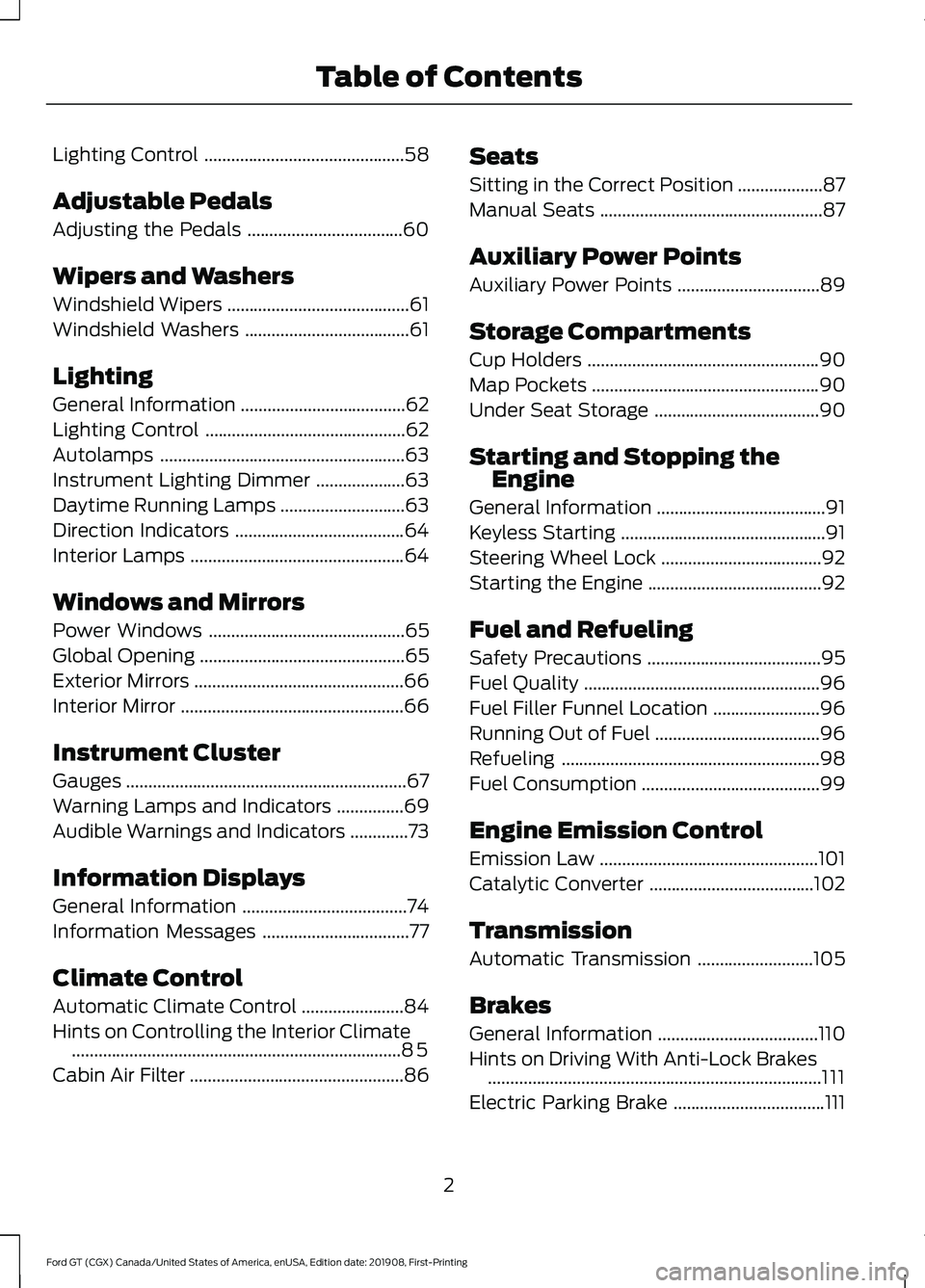
Lighting Control
.............................................58
Adjustable Pedals
Adjusting the Pedals ...................................
60
Wipers and Washers
Windshield Wipers .........................................
61
Windshield Washers .....................................
61
Lighting
General Information .....................................
62
Lighting Control .............................................
62
Autolamps .......................................................
63
Instrument Lighting Dimmer ....................
63
Daytime Running Lamps ............................
63
Direction Indicators ......................................
64
Interior Lamps ................................................
64
Windows and Mirrors
Power Windows ............................................
65
Global Opening ..............................................
65
Exterior Mirrors ...............................................
66
Interior Mirror ..................................................
66
Instrument Cluster
Gauges ...............................................................
67
Warning Lamps and Indicators ...............
69
Audible Warnings and Indicators .............
73
Information Displays
General Information .....................................
74
Information Messages .................................
77
Climate Control
Automatic Climate Control .......................
84
Hints on Controlling the Interior Climate ........................................................................\
..
85
Cabin Air Filter ................................................
86Seats
Sitting in the Correct Position
...................
87
Manual Seats ..................................................
87
Auxiliary Power Points
Auxiliary Power Points ................................
89
Storage Compartments
Cup Holders ....................................................
90
Map Pockets ...................................................
90
Under Seat Storage .....................................
90
Starting and Stopping the Engine
General Information ......................................
91
Keyless Starting ..............................................
91
Steering Wheel Lock ....................................
92
Starting the Engine .......................................
92
Fuel and Refueling
Safety Precautions .......................................
95
Fuel Quality .....................................................
96
Fuel Filler Funnel Location ........................
96
Running Out of Fuel .....................................
96
Refueling ..........................................................
98
Fuel Consumption ........................................
99
Engine Emission Control
Emission Law .................................................
101
Catalytic Converter .....................................
102
Transmission
Automatic Transmission ..........................
105
Brakes
General Information ....................................
110
Hints on Driving With Anti-Lock Brakes ........................................................................\
...
111
Electric Parking Brake ..................................
111
2
Ford GT (CGX) Canada/United States of America, enUSA, Edition date: 201908, First-Printing Table of Contents
Page 7 of 316
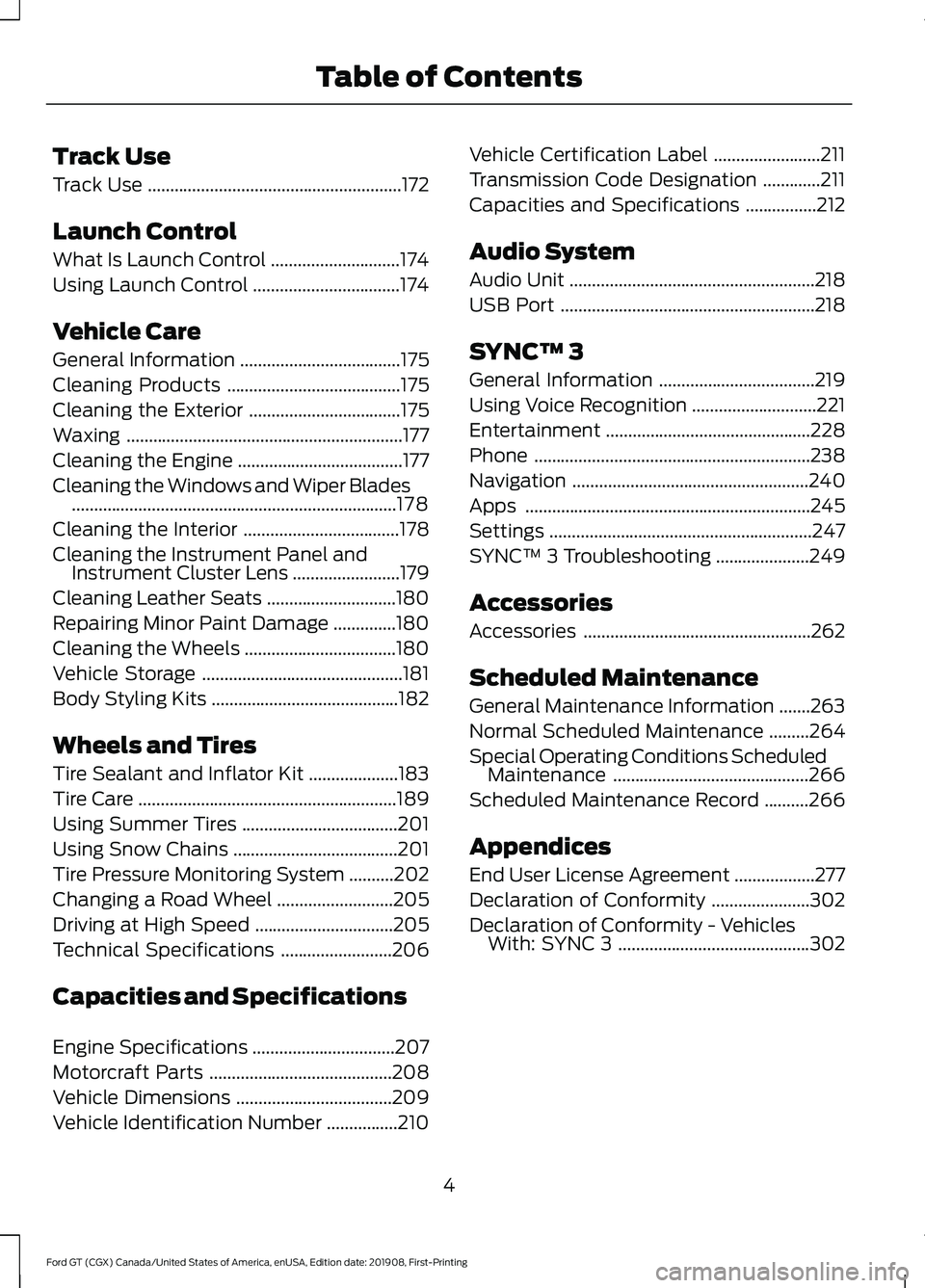
Track Use
Track Use
.........................................................172
Launch Control
What Is Launch Control .............................
174
Using Launch Control .................................
174
Vehicle Care
General Information ....................................
175
Cleaning Products .......................................
175
Cleaning the Exterior ..................................
175
Waxing ..............................................................
177
Cleaning the Engine .....................................
177
Cleaning the Windows and Wiper Blades ........................................................................\
.
178
Cleaning the Interior ...................................
178
Cleaning the Instrument Panel and Instrument Cluster Lens ........................
179
Cleaning Leather Seats .............................
180
Repairing Minor Paint Damage ..............
180
Cleaning the Wheels ..................................
180
Vehicle Storage .............................................
181
Body Styling Kits ..........................................
182
Wheels and Tires
Tire Sealant and Inflator Kit ....................
183
Tire Care ..........................................................
189
Using Summer Tires ...................................
201
Using Snow Chains .....................................
201
Tire Pressure Monitoring System ..........
202
Changing a Road Wheel ..........................
205
Driving at High Speed ...............................
205
Technical Specifications .........................
206
Capacities and Specifications
Engine Specifications ................................
207
Motorcraft Parts .........................................
208
Vehicle Dimensions ...................................
209
Vehicle Identification Number ................
210Vehicle Certification Label
........................
211
Transmission Code Designation .............
211
Capacities and Specifications ................
212
Audio System
Audio Unit .......................................................
218
USB Port .........................................................
218
SYNC™ 3
General Information ...................................
219
Using Voice Recognition ............................
221
Entertainment ..............................................
228
Phone ..............................................................
238
Navigation .....................................................
240
Apps ................................................................
245
Settings ...........................................................
247
SYNC™ 3 Troubleshooting .....................
249
Accessories
Accessories ...................................................
262
Scheduled Maintenance
General Maintenance Information .......
263
Normal Scheduled Maintenance .........
264
Special Operating Conditions Scheduled Maintenance ............................................
266
Scheduled Maintenance Record ..........
266
Appendices
End User License Agreement ..................
277
Declaration of Conformity ......................
302
Declaration of Conformity - Vehicles With: SYNC 3 ...........................................
302
4
Ford GT (CGX) Canada/United States of America, enUSA, Edition date: 201908, First-Printing Table of Contents
Page 8 of 316
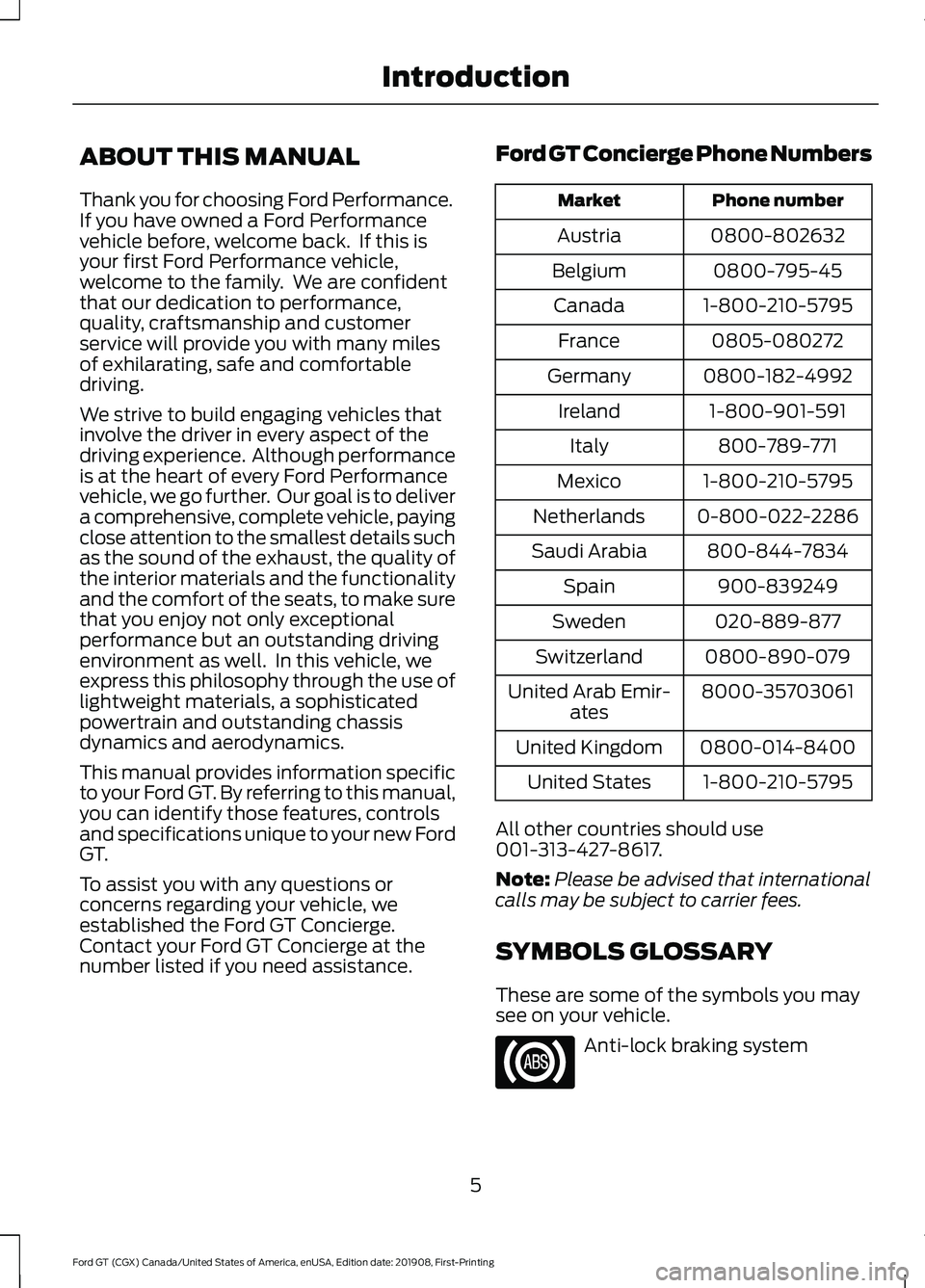
ABOUT THIS MANUAL
Thank you for choosing Ford Performance.
If you have owned a Ford Performance
vehicle before, welcome back. If this is
your first Ford Performance vehicle,
welcome to the family. We are confident
that our dedication to performance,
quality, craftsmanship and customer
service will provide you with many miles
of exhilarating, safe and comfortable
driving.
We strive to build engaging vehicles that
involve the driver in every aspect of the
driving experience. Although performance
is at the heart of every Ford Performance
vehicle, we go further. Our goal is to deliver
a comprehensive, complete vehicle, paying
close attention to the smallest details such
as the sound of the exhaust, the quality of
the interior materials and the functionality
and the comfort of the seats, to make sure
that you enjoy not only exceptional
performance but an outstanding driving
environment as well. In this vehicle, we
express this philosophy through the use of
lightweight materials, a sophisticated
powertrain and outstanding chassis
dynamics and aerodynamics.
This manual provides information specific
to your Ford GT. By referring to this manual,
you can identify those features, controls
and specifications unique to your new Ford
GT.
To assist you with any questions or
concerns regarding your vehicle, we
established the Ford GT Concierge.
Contact your Ford GT Concierge at the
number listed if you need assistance.
Ford GT Concierge Phone Numbers Phone number
Market
0800-802632
Austria
0800-795-45
Belgium
1-800-210-5795
Canada
0805-080272
France
0800-182-4992
Germany
1-800-901-591
Ireland
800-789-771
Italy
1-800-210-5795
Mexico
0-800-022-2286
Netherlands
800-844-7834
Saudi Arabia
900-839249
Spain
020-889-877
Sweden
0800-890-079
Switzerland
8000-35703061
United Arab Emir-
ates
0800-014-8400
United Kingdom
1-800-210-5795
United States
All other countries should use
001-313-427-8617.
Note: Please be advised that international
calls may be subject to carrier fees.
SYMBOLS GLOSSARY
These are some of the symbols you may
see on your vehicle. Anti-lock braking system
5
Ford GT (CGX) Canada/United States of America, enUSA, Edition date: 201908, First-Printing Introduction
Page 23 of 316

Recommendations for Safety Restraints for Children
Recommended Restraint
Type
Child Size, Height, Weight, or Age
Child
Use a child restraint
(sometimes called an
infant carrier, convertible seat, or toddler seat).
Children weighing 40 lb (18 kg) or less
(generally age four or younger).
Infants or
toddlers
Use a belt-positioningbooster seat.
Children who have outgrown or no longer
properly fit in a child restraint (generally
children who are less than 57 in (1.45 m)
tall, are greater than age four and less
than age 12, and between 40 lb (18 kg)
and 80 lb (36 kg) and upward to 100 lb (45 kg) if recommended by your child restraint manufacturer).
Small children
Use a vehicle seatbelt
having the lap belt snug
and low across the hips, shoulder belt centered
across the shoulder and
chest, and seat backrest upright.
Children who have outgrown or no longer
properly fit in a belt-positioning booster
seat (generally children who are at least 57 in (1.45 m)
tall or greater than 80 lb
(36 kg) or 100 lb (45 kg) if recommended by child restraint manufacturer).
Larger children
• You are required by law to properly use
child restraints for infants and toddlers
in the United States and Canada.
• Many states and provinces require that
small children use approved booster
seats until they reach age eight, a
height of
57 in (1.45 m) tall, or 80
pounds (36 kilograms). Check your
local and state or provincial laws for
specific requirements about the safety
of children in your vehicle. INSTALLING CHILD
RESTRAINTS
Child Seats
20
Ford GT (CGX) Canada/United States of America, enUSA, Edition date: 201908, First-Printing Child SafetyE142594
Page 27 of 316
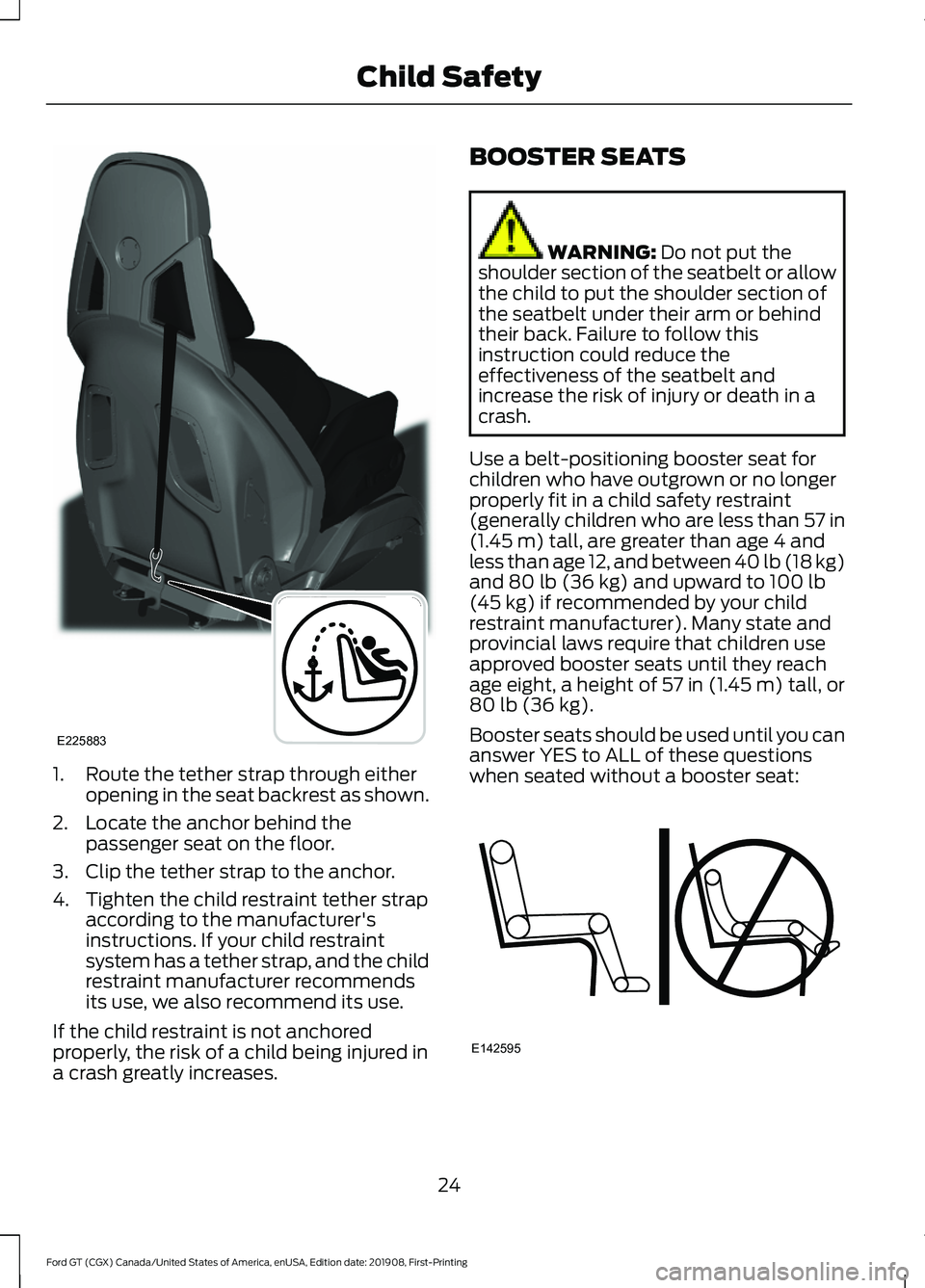
1. Route the tether strap through either
opening in the seat backrest as shown.
2. Locate the anchor behind the passenger seat on the floor.
3. Clip the tether strap to the anchor.
4. Tighten the child restraint tether strap according to the manufacturer's
instructions. If your child restraint
system has a tether strap, and the child
restraint manufacturer recommends
its use, we also recommend its use.
If the child restraint is not anchored
properly, the risk of a child being injured in
a crash greatly increases. BOOSTER SEATS WARNING: Do not put the
shoulder section of the seatbelt or allow
the child to put the shoulder section of
the seatbelt under their arm or behind
their back. Failure to follow this
instruction could reduce the
effectiveness of the seatbelt and
increase the risk of injury or death in a
crash.
Use a belt-positioning booster seat for
children who have outgrown or no longer
properly fit in a child safety restraint
(generally children who are less than
57 in
(1.45 m) tall, are greater than age 4 and
less than age 12, and between 40 lb (18 kg)
and
80 lb (36 kg) and upward to 100 lb
(45 kg) if recommended by your child
restraint manufacturer). Many state and
provincial laws require that children use
approved booster seats until they reach
age eight, a height of
57 in (1.45 m) tall, or
80 lb (36 kg).
Booster seats should be used until you can
answer YES to ALL of these questions
when seated without a booster seat: 24
Ford GT (CGX) Canada/United States of America, enUSA, Edition date: 201908, First-Printing Child SafetyE225883 E142595
Page 28 of 316
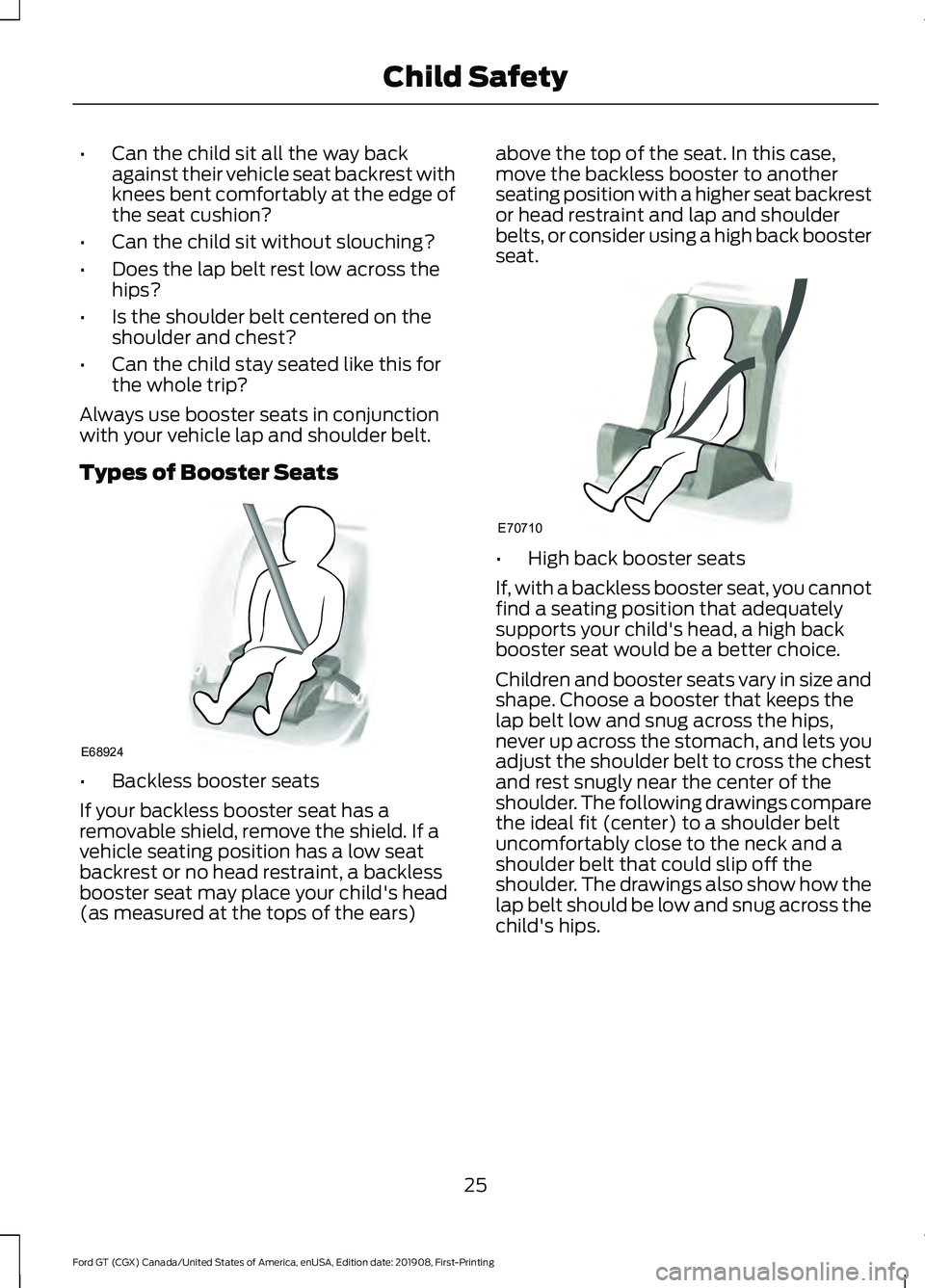
•
Can the child sit all the way back
against their vehicle seat backrest with
knees bent comfortably at the edge of
the seat cushion?
• Can the child sit without slouching?
• Does the lap belt rest low across the
hips?
• Is the shoulder belt centered on the
shoulder and chest?
• Can the child stay seated like this for
the whole trip?
Always use booster seats in conjunction
with your vehicle lap and shoulder belt.
Types of Booster Seats •
Backless booster seats
If your backless booster seat has a
removable shield, remove the shield. If a
vehicle seating position has a low seat
backrest or no head restraint, a backless
booster seat may place your child's head
(as measured at the tops of the ears) above the top of the seat. In this case,
move the backless booster to another
seating position with a higher seat backrest
or head restraint and lap and shoulder
belts, or consider using a high back booster
seat.
•
High back booster seats
If, with a backless booster seat, you cannot
find a seating position that adequately
supports your child's head, a high back
booster seat would be a better choice.
Children and booster seats vary in size and
shape. Choose a booster that keeps the
lap belt low and snug across the hips,
never up across the stomach, and lets you
adjust the shoulder belt to cross the chest
and rest snugly near the center of the
shoulder. The following drawings compare
the ideal fit (center) to a shoulder belt
uncomfortably close to the neck and a
shoulder belt that could slip off the
shoulder. The drawings also show how the
lap belt should be low and snug across the
child's hips.
25
Ford GT (CGX) Canada/United States of America, enUSA, Edition date: 201908, First-Printing Child SafetyE68924 E70710
Page 31 of 316

PRINCIPLE OF OPERATION
WARNING: Always drive and
ride with your seatback upright and the
lap belt snug and low across the hips. WARNING:
Children must
always be properly restrained. WARNING:
Do not allow a
passenger to hold a child on their lap
when your vehicle is moving. Failure to
follow this instruction could result in
personal injury or death in the event of a
sudden stop or crash. WARNING: All occupants of your
vehicle, including the driver, should
always properly wear their seatbelts,
even when an airbag supplemental
restraint system is provided. Failure to
properly wear your seatbelt could
seriously increase the risk of injury or
death. WARNING:
It is extremely
dangerous to ride in a cargo area, inside
or outside of a vehicle. In a crash, people
riding in these areas are more likely to be
seriously injured or killed. Do not allow
people to ride in any area of your vehicle
that is not equipped with seats and
seatbelts. Make sure everyone in your
vehicle is in a seat and properly using a
seatbelt. Failure to follow this warning
could result in serious personal injury or
death. WARNING:
In a rollover crash,
an unbelted person is significantly more
likely to die than a person wearing a
seatbelt. WARNING:
Each seating
position in your vehicle has a specific
seatbelt assembly made up of one
buckle and one tongue designed to be
used as a pair. Use the shoulder belt on
the outside shoulder only. Never wear
the shoulder belt under the arm. Never
use a single seatbelt for more than one
person. WARNING:
Seatbelts and seats
may be hot in a vehicle that is in the
sunshine. The hot seatbelts or seats may
burn a small child. Check seat covers and
buckles before you place a child
anywhere near them.
All seating positions in your vehicle have
lap and shoulder seatbelts. All occupants
of the vehicle should always properly wear
their seatbelts, even when an airbag
supplemental restraint system is provided.
The seatbelt system consists of:
• Lap and shoulder seatbelts.
• Seatbelt pretensioner at the front
outermost seating positions.
• Belt tension sensor at the front
outermost passenger seating position. · Seatbelt warning light and
chime.
· Crash sensors and monitoring
system with readiness indicator.
28
Ford GT (CGX) Canada/United States of America, enUSA, Edition date: 201908, First-Printing SeatbeltsE71880 E67017
Page 88 of 316
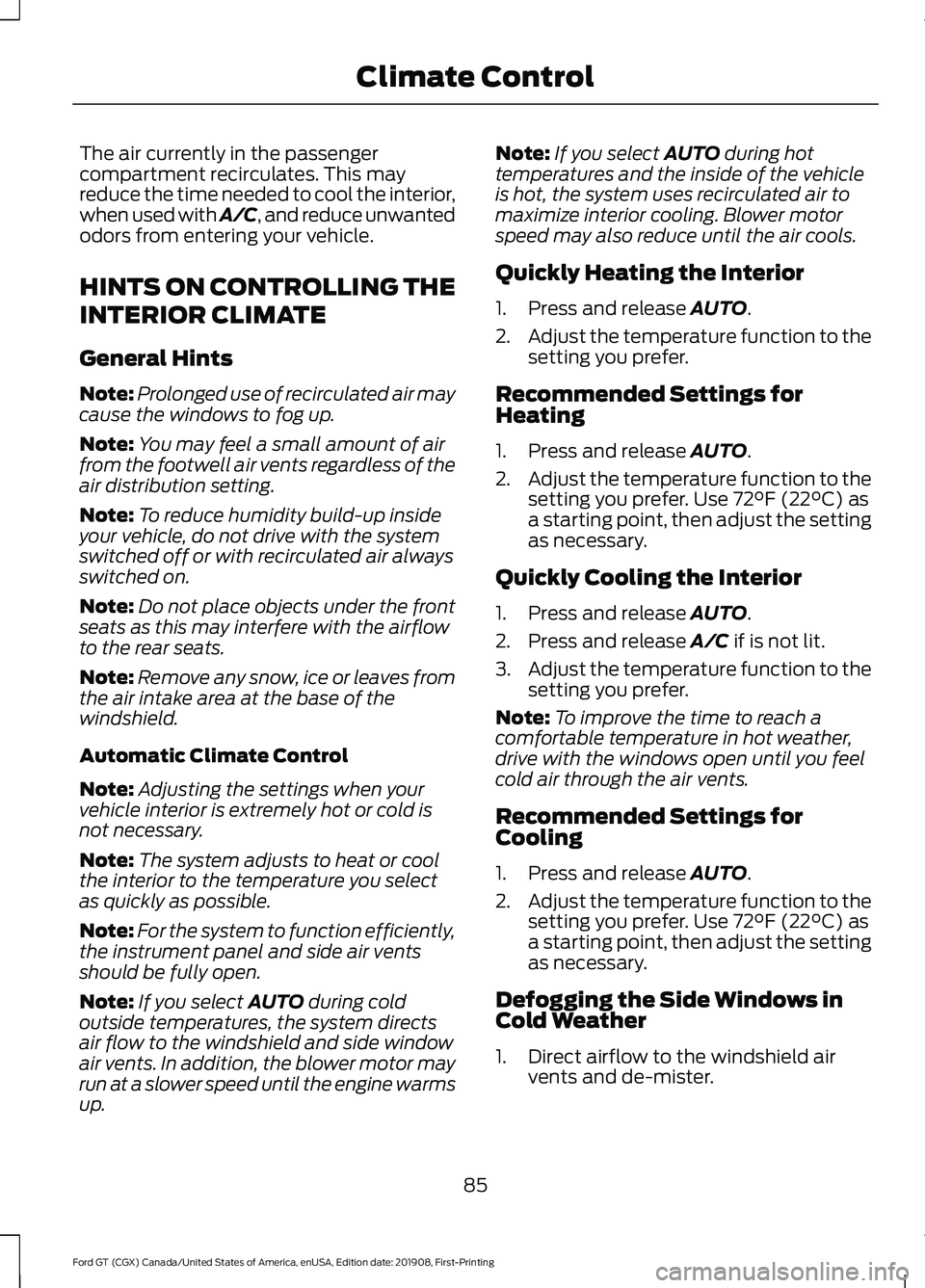
The air currently in the passenger
compartment recirculates. This may
reduce the time needed to cool the interior,
when used with A/C, and reduce unwanted
odors from entering your vehicle.
HINTS ON CONTROLLING THE
INTERIOR CLIMATE
General Hints
Note:
Prolonged use of recirculated air may
cause the windows to fog up.
Note: You may feel a small amount of air
from the footwell air vents regardless of the
air distribution setting.
Note: To reduce humidity build-up inside
your vehicle, do not drive with the system
switched off or with recirculated air always
switched on.
Note: Do not place objects under the front
seats as this may interfere with the airflow
to the rear seats.
Note: Remove any snow, ice or leaves from
the air intake area at the base of the
windshield.
Automatic Climate Control
Note: Adjusting the settings when your
vehicle interior is extremely hot or cold is
not necessary.
Note: The system adjusts to heat or cool
the interior to the temperature you select
as quickly as possible.
Note: For the system to function efficiently,
the instrument panel and side air vents
should be fully open.
Note: If you select AUTO during cold
outside temperatures, the system directs
air flow to the windshield and side window
air vents. In addition, the blower motor may
run at a slower speed until the engine warms
up. Note:
If you select
AUTO during hot
temperatures and the inside of the vehicle
is hot, the system uses recirculated air to
maximize interior cooling. Blower motor
speed may also reduce until the air cools.
Quickly Heating the Interior
1. Press and release
AUTO.
2. Adjust the temperature function to the
setting you prefer.
Recommended Settings for
Heating
1. Press and release
AUTO.
2. Adjust the temperature function to the
setting you prefer. Use
72°F (22°C) as
a starting point, then adjust the setting
as necessary.
Quickly Cooling the Interior
1. Press and release
AUTO.
2. Press and release
A/C if is not lit.
3. Adjust the temperature function to the
setting you prefer.
Note: To improve the time to reach a
comfortable temperature in hot weather,
drive with the windows open until you feel
cold air through the air vents.
Recommended Settings for
Cooling
1. Press and release
AUTO.
2. Adjust the temperature function to the
setting you prefer. Use
72°F (22°C) as
a starting point, then adjust the setting
as necessary.
Defogging the Side Windows in
Cold Weather
1. Direct airflow to the windshield air vents and de-mister.
85
Ford GT (CGX) Canada/United States of America, enUSA, Edition date: 201908, First-Printing Climate Control
Page 90 of 316
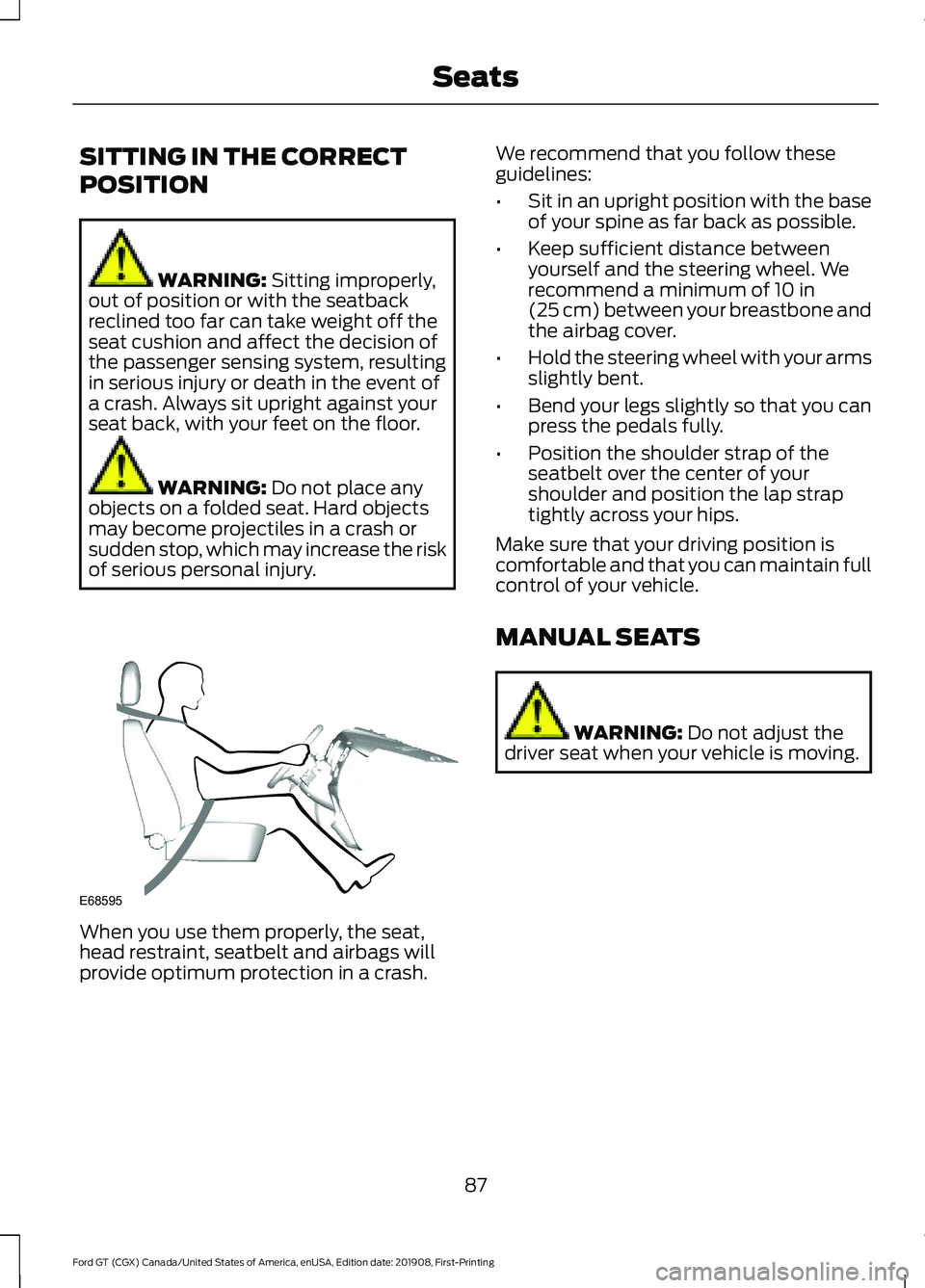
SITTING IN THE CORRECT
POSITION
WARNING: Sitting improperly,
out of position or with the seatback
reclined too far can take weight off the
seat cushion and affect the decision of
the passenger sensing system, resulting
in serious injury or death in the event of
a crash. Always sit upright against your
seat back, with your feet on the floor. WARNING:
Do not place any
objects on a folded seat. Hard objects
may become projectiles in a crash or
sudden stop, which may increase the risk
of serious personal injury. When you use them properly, the seat,
head restraint, seatbelt and airbags will
provide optimum protection in a crash. We recommend that you follow these
guidelines:
•
Sit in an upright position with the base
of your spine as far back as possible.
• Keep sufficient distance between
yourself and the steering wheel. We
recommend a minimum of
10 in
(25 cm) between your breastbone and
the airbag cover.
• Hold the steering wheel with your arms
slightly bent.
• Bend your legs slightly so that you can
press the pedals fully.
• Position the shoulder strap of the
seatbelt over the center of your
shoulder and position the lap strap
tightly across your hips.
Make sure that your driving position is
comfortable and that you can maintain full
control of your vehicle.
MANUAL SEATS WARNING:
Do not adjust the
driver seat when your vehicle is moving.
87
Ford GT (CGX) Canada/United States of America, enUSA, Edition date: 201908, First-Printing SeatsE68595